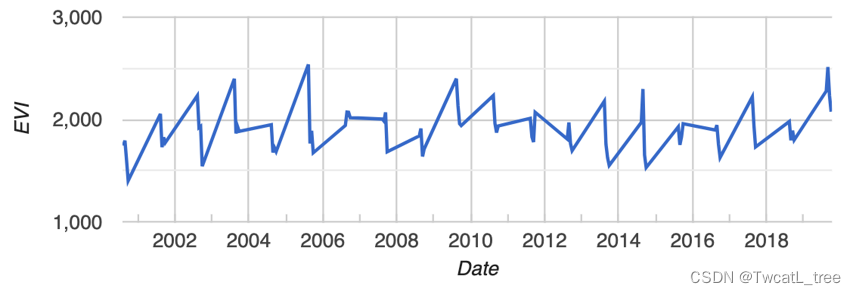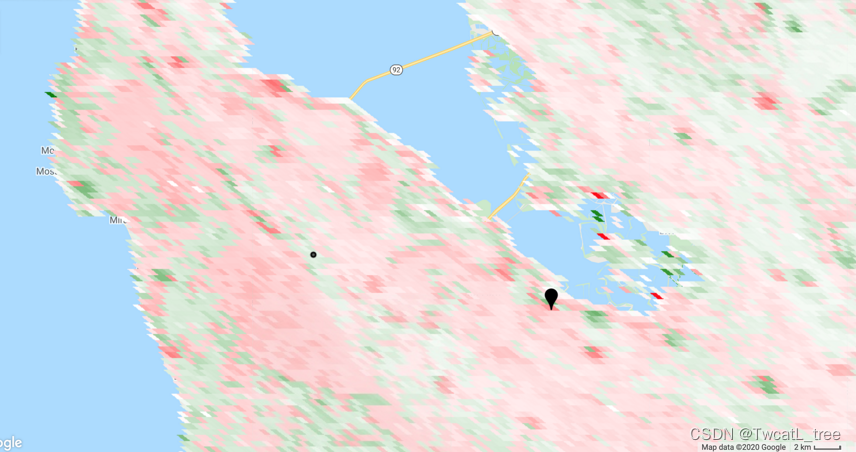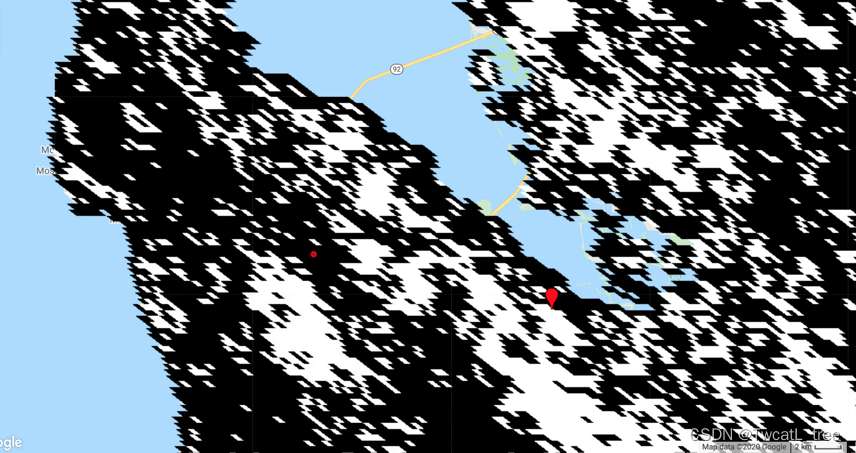GEE非参数趋势分析(Mk-Sen)
趋势分析是寻找感兴趣的东西正在增加的地方,或者 减少多少。更具体地说,本教程演示了 使用非参数 Mann-Kendall 检测影像中的单调趋势 测试是否存在增加或减少的趋势以及 Sen 的斜率 量化趋势的幅度(如果存在)。本教程还显示 估计 Mann-Kendall 检验统计量的方差,Mann Kendall 检验统计量是 检验是否存在任何趋势,以及统计量的 P 值(假设 正态分布)。 重要提示:此处介绍的方法 适用于评估单调趋势(即没有季节性的数据) 在离散数据中(即非浮点)。此外,如果应用 本教程中的方法对新数据(即地区、时间范围、来源)可以 需要调整和可视化参数以适应 特别的结果。
时间序列数据 我们将使用来自MOD13A1数据集的MODIS增强植被指数(EVI)的时间序列。此图像集合的每个像素都包含一个时间序列,我们 将计算每个像素的统计信息。假设将集合筛选为 一个季节足以获得具有单调趋势的时间序列。自 检查该假设是否适用于您感兴趣的领域,添加 收集到地图并使用检查器,单击一些点并查看 控制台中显示的系列图表。根据需要调整过滤器。
var mod13 = ee.ImageCollection('MODIS/006/MOD13A1');
var coll = mod13.select('EVI')
.filter(ee.Filter.calendarRange(8, 9, 'month'));
Map.setCenter(-121.6, 37.3, 10);
Map.addLayer(coll, {min: -500, max: 5000, palette: ['white', 'green']}, 'coll');此集合中的 EVI 时间序列(一个像素)示例如下所示。是 这个像素有趋势吗?更重要的是,从统计学上讲,这是一个 这个像素的显着趋势?请继续阅读,找出答案!
EVI time series in a single pixel

将时间序列连接到自身 感兴趣的非参数统计是通过检查所有可能的来计算的 时间序列中唯一值的排序对。如果有 n 个时间点 在序列中,我们需要检查 N(N-1)/2 对 (i, j),i<j,其中 i 和 j 是任意时间索引。(这里我们用(i,j)来表示 由 i 和 j 索引的一对 EVI 图像)。为此,请将集合加入到 本身带有时间过滤器。时态过滤器将通过所有 按时间顺序排列的后期图像。在联接的集合中,每个图像都将 将它之后的所有图像存储在属性中。after
var afterFilter = ee.Filter.lessThan({
leftField: 'system:time_start',
rightField: 'system:time_start'
});
var joined = ee.ImageCollection(ee.Join.saveAll('after').apply({
primary: coll,
secondary: coll,
condition: afterFilter
}));Mann-Kendall 趋势检验 Mann-Kendall 趋势定义为所有货币对的符号之和。 如果时间 j 的 EVI 大于时间 i 的 EVI,则为 1,如果 相反是真的,否则为零(如果它们相等)。计算方式 循环访问集合并计算集合中的每个图像和图像中的每个图像。signsign(i, j)ijafter
var sign = function(i, j) { // i and j are images
return ee.Image(j).neq(i) // Zero case
.multiply(ee.Image(j).subtract(i).clamp(-1, 1)).int();
};
var kendall = ee.ImageCollection(joined.map(function(current) {
var afterCollection = ee.ImageCollection.fromImages(current.get('after'));
return afterCollection.map(function(image) {
// The unmask is to prevent accumulation of masked pixels that
// result from the undefined case of when either current or image
// is masked. It won't affect the sum, since it's unmasked to zero.
return ee.Image(sign(current, image)).unmask(0);
});
// Set parallelScale to avoid User memory limit exceeded.
}).flatten()).reduce('sum', 2);
var palette = ['red', 'white', 'green'];
// Set min and max stretch visualization parameters as necessary.
Map.addLayer(kendall, {palette: palette, min: -2800, max: 2800}, 'kendall');缩放到您感兴趣的区域并定义大致对称的颜色拉伸 使用地图图层样式设置对话框(即 和 的均值 近似为零)。红色像素呈递减趋势,绿色像素呈递减趋势 像素呈增加趋势。如下图所示 美国加利福尼亚州一个地区的 Mann-Kendall 统计量。地图图钉是 在 Googleplex 的大致位置。该点是 从中提取上述时间序列的点。我们想要 以确定此地图中的哪些像素具有显著趋势。minmax

您可能还想知道趋势的幅度或斜率 在当前背景下随时间推移的趋势。一种非参数化方式 用森的斜率来评估。
森氏斜坡 Sen 斜率的计算方式与 Mann-Kendall 统计量类似。 但是,不是将所有符号对相加,而是计算斜率 对于所有对。Sen 斜率是所有这些对的中位斜率。在 在下文中,斜率是以天为单位计算的,以避免数值上的微小斜率 (这可能是由于改用纪元时间而产生的)。
var slope = function(i, j) { // i and j are images
return ee.Image(j).subtract(i)
.divide(ee.Image(j).date().difference(ee.Image(i).date(), 'days'))
.rename('slope')
.float();
};
var slopes = ee.ImageCollection(joined.map(function(current) {
var afterCollection = ee.ImageCollection.fromImages(current.get('after'));
return afterCollection.map(function(image) {
return ee.Image(slope(current, image));
});
}).flatten());
var sensSlope = slopes.reduce(ee.Reducer.median(), 2); // Set parallelScale.
Map.addLayer(sensSlope, {palette: palette, min: -1, max: 1}, 'sensSlope');要获取 Sen 的截距(如果需要),请计算所有截距并取 中位数。
var epochDate = ee.Date('1970-01-01');
var sensIntercept = coll.map(function(image) {
var epochDays = image.date().difference(epochDate, 'days').float();
return image.subtract(sensSlope.multiply(epochDays)).float();
}).reduce(ee.Reducer.median(), 2);
Map.addLayer(sensIntercept, {min: -6600, max: 20600}, 'sensIntercept');森的斜坡图如下所示。请注意,该模式类似于 Mann-Kendall 统计量,但不完全相同。此外,还有 哪些像素具有显着趋势的问题,这个问题将 很快得到答复。

前面的示例仅用于演示计算。如果你需要 Sen 的斜率和/或截距,您还可以使用 Sen 的斜率减速器,它可能更容易(更少的代码)和更高的效率,但计算 intercept 作为通过中位数的线的 y 值。
Mann-Kendall 统计量的方差 计算 Mann-Kendall 统计量的方差时,由于 数据中可能存在联系(即 等于零)。 计算这些关系可能会有点棘手,需要基于数组 前向差分。请注意,您可以在计算中评论您是否不关心领带和 想要忽略该更正。sign(i, j).subtract(groupFactorSum)kendallVariance
// Values that are in a group (ties). Set all else to zero.
var groups = coll.map(function(i) {
var matches = coll.map(function(j) {
return i.eq(j); // i and j are images.
}).sum();
return i.multiply(matches.gt(1));
});
// Compute tie group sizes in a sequence. The first group is discarded.
var group = function(array) {
var length = array.arrayLength(0);
// Array of indices. These are 1-indexed.
var indices = ee.Image([1])
.arrayRepeat(0, length)
.arrayAccum(0, ee.Reducer.sum())
.toArray(1);
var sorted = array.arraySort();
var left = sorted.arraySlice(0, 1);
var right = sorted.arraySlice(0, 0, -1);
// Indices of the end of runs.
var mask = left.neq(right)
// Always keep the last index, the end of the sequence.
.arrayCat(ee.Image(ee.Array([[1]])), 0);
var runIndices = indices.arrayMask(mask);
// Subtract the indices to get run lengths.
var groupSizes = runIndices.arraySlice(0, 1)
.subtract(runIndices.arraySlice(0, 0, -1));
return groupSizes;
};
// See equation 2.6 in Sen (1968).
var factors = function(image) {
return image.expression('b() * (b() - 1) * (b() * 2 + 5)');
};
var groupSizes = group(groups.toArray());
var groupFactors = factors(groupSizes);
var groupFactorSum = groupFactors.arrayReduce('sum', [0])
.arrayGet([0, 0]);
var count = joined.count();
var kendallVariance = factors(count)
.subtract(groupFactorSum)
.divide(18)
.float();
Map.addLayer(kendallVariance, {min: 1700, max: 85000}, 'kendallVariance');显著性检验 Mann-Kendall 统计量对于适当大 样品。假设我们的样本足够大且不相关。在这些之下 假设,Mann-Kendall 统计量的真实均值为零,并且 方差如上计算。要计算标准正态统计量 (), 将统计量除以其标准差。z 统计量的 P 值 (观察到这种极值的概率)是 1 - P(|z| < Z)。为 对是否存在任何趋势(正或负)的双侧测试 95% 置信水平,将 P 值与 0.975 进行比较。(或者,比较 Z* 的 z 统计量,其中 Z* 是逆分布函数 0.975)。z
标准正态分布函数可以在 Earth Engine 中计算得出 error 函数 .分布函数及其逆函数 如下所示以供参考。在这里,我们使用分布函数得到 1 - P(|z| < Z) 并将其与 0.975 进行比较。erf()
// Compute Z-statistics.
var zero = kendall.multiply(kendall.eq(0));
var pos = kendall.multiply(kendall.gt(0)).subtract(1);
var neg = kendall.multiply(kendall.lt(0)).add(1);
var z = zero
.add(pos.divide(kendallVariance.sqrt()))
.add(neg.divide(kendallVariance.sqrt()));
Map.addLayer(z, {min: -2, max: 2}, 'z');
// https://en.wikipedia.org/wiki/Error_function#Cumulative_distribution_function
function eeCdf(z) {
return ee.Image(0.5)
.multiply(ee.Image(1).add(ee.Image(z).divide(ee.Image(2).sqrt()).erf()));
}
function invCdf(p) {
return ee.Image(2).sqrt()
.multiply(ee.Image(p).multiply(2).subtract(1).erfInv());
}
// Compute P-values.
var p = ee.Image(1).subtract(eeCdf(z.abs()));
Map.addLayer(p, {min: 0, max: 1}, 'p');
// Pixels that can have the null hypothesis (there is no trend) rejected.
// Specifically, if the true trend is zero, there would be less than 5%
// chance of randomly obtaining the observed result (that there is a trend).
Map.addLayer(p.lte(0.025), {min: 0, max: 1}, 'significant trends');下面显示了“有效”像素(白色)的映射,或 通过测试的像素。如果我们的假设是正确的 并且您对计算感到满意,您可能希望处理这些 像素不同,用作蒙版。请注意,像素 上面显示的时间序列(下图中的红色)没有 显著趋势。p.lte(0.025)p.lte(0.025)

有人称这个过程为显著性测试。“重要”的像素 满足条件,并假定具有实数 趋势。其他像素被假定为没有趋势,并从 进一步分析。有些人认为这个过程是邪教 (Ziliak 和 McCloskey 2009)。 由您决定!p.lte(0.025)
